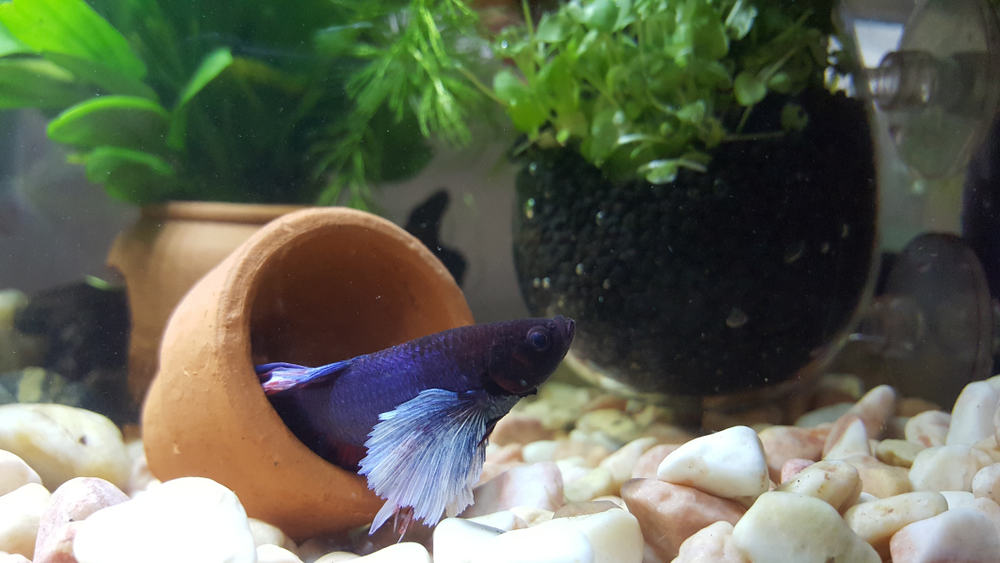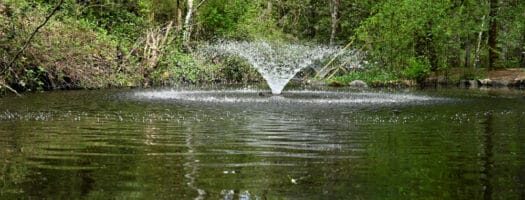The 10 Best Betta Foods to Buy in 2025

Sitting serenely in their aquarium looking out at the world, your Betta can bring a sense of tranquility quite unlike any other pet. While they may be Zen-like in their approach to life despite their violent reputations, they do feed like fighters. Of course, keeping them alive is crucial first and foremost, but the importance of a good diet plays a vital part in keeping your fish healthy and happy.
One thing affected by the food they eat is the vibrancy of their colors, but their mood and behavior are also reliant on a decent diet. Here we’ll take a closer look at what that means, the food you can buy, and how you best take care of your Betta fish when feeding them.
- What to Consider When Feeding Your Betta
- Top 10 Best Betta Foods to Buy in 2025
- 1. Best Overall Betta Food: TetraMin Tropical Flake Food
- 2. Best Balanced Betta Food: Hikari Bio-Gold Baby Pellets
- 3. Best Small Betta Food: Fluval Bug Bites Granules
- 4. Best Budget Betta Food: Tetra Floating Mini Pellets
- 5. Best Premium Betta Food: Ocean Nutrition Betta Pellets
- 6. Best Bloodworms for Bettas: San Francisco Bay Bloodworms
- 7. Best Natural Betta Food: Aqueon Pro Betta Pellet
- 8. Best Freeze-Dried Betta Food: Hikari Freeze-Dried Daphnia
- 9. Best Sinking Pellets for Bettas: New Life Spectrum
- 10. Best Shrimp for Bettas: Omega One Brine Shrimp
- Guide to Buying the Best Betta Food in 2025
- Fish Food for Thought
What to Consider When Feeding Your Betta
There’s a lot to take onboard when feeding your Betta, whether you’re a newcomer or expert, as they can vary wildly in both tastes and requirements. So let’s take a look at the basics of what you can offer your Betta fish, the best ways to feed them, and then get down to our top fish food picks.
Types of Betta Food
As it is with their human owners, Betta fish also have their own distinctive set of tastes and preferences. You must find where your Betta’s lie through a process of trial and error, making sure they’re comfortable all the way. That said, you should make yourself aware of the different food types and what they offer from the outset.
Pellets
As mentioned earlier, these are literal ‘pellets’ of condensed floating food ready for hoovering up effortlessly by the little swimmers. It’s best to opt for the pellets that float the longest, although sinking pellets are an option if needs be. Occasionally Bettas prefer sinking pellets, so be sure to give these if shot if they aren’t nibbling any surface food. Just make sure they contain at least 30% crude protein in them, and you should be good to go.
Flakes
One of the most popular and well-known fish foods out there, these simply sprinkle along the surface, offering straightforward convenience. You should make sure to vary these with other food sources, as they don’t always cover everything when it comes to a full diet. There’s also some difficulty in judging how much is required, along with them sinking if not broken up enough. They take some getting used to, so experiment a little and find the right amount for your fish by timing how much they consume in a few minutes. The label should also be able to help you here.
Live Food
If you can find your fish a regular supply of live fish food, then great. Granted, this isn’t easy or convenient for most people. When you get a chance, though, make sure to give them a rare little treat, as hunting is natural to Bettas and gives them a chance to shine. You’ll mostly be looking at insects, brine shrimp, Daphnia, and mosquito larvae. Just be sure to see that it’s fresh, without any extra unwanted parasite infections.
You can purchase live-food from the internet, but this is relatively risky given that not only is it prone to parasites, it’s also costly. If there’s no other alternative and your Betta want only the best, then be sure to shop around. There are some reputable retailers out there, but you will need to do your research thoroughly.
Frozen Food
Similar to live food, except that it’s frozen, meaning that it’s a little easier to store. You also reduce the risk of contamination, with fewer chances of parasites, plus it has a longer lifespan. There’s less nutrition in frozen than in live food, though, plus hunting isn’t an option, but it’s cheaper and more viable.
Freeze-Dried
Working as an even more readily available alternative to live foods or frozen foods, this is essentially the same but with all the moisture removed. Essentially you want to use these as a treat, maybe once or twice a week. They shouldn’t replace regular meals though, as not only is a balanced diet vital, but they should also be something they look forward to, like fishy chocolate ice-cream!
What to Look For in Betta Food
Paying attention to the ingredients is always essential, as quality fish food is only as good as what goes into it. We’d all rather stay away from junk food, and the same goes for Betta, so what exactly should we look for in our fish food?
Ingredients to Look For
- Insects And Larvae: a significant part of their natural diet, there’s plenty of products out there with ingredients such as Soldier Fly larvae in them. These help to form part of a balanced diet.
- Pure Meats: primarily consuming smaller, meatier animals, it’s essential to remember where the Betta is on the food chain. With ingredients such as Salmon and freeze-dried/live food available, there’s plenty of high-quality, high-protein meals.
- Vitamins and Stimulants: this will include ProCare, along with Vitamin C and Omega, all working together to help bolster the immune system and enhance color.
Ingredients to Avoid
- Low-Quality Fish Meal: don’t be deceived by the name, as it’s merely mass-produced meat offshoots packed together with other unknown ingredients. Although many quality products will also use this, it’s likely not the best if it’s central to the food. We’ve only included products that contain a limited amount of high-quality fish meal on our list.
- Too Much Plant Food: some plant ingredients are fine, but you need to remember that Betta fish are carnivores first and foremost. With many generic foods targeted at omnivores, Betta cannot digest plants, especially in large quantities.
- Unidentified Filler: this goes without saying as, similar to Fish Meal, there’s plenty of ingredients simply thrown in to pad the product out. If you can’t gain a clear picture of exactly what you’re feeding your fish, it’s best not to bother.
We’ll get into how to properly feed your Betta in greater detail below, but now that you know everything to keep in mind let’s get into our picks for the best products available today.
Top 10 Best Betta Foods to Buy in 2025
1. Best Overall Betta Food: TetraMin Tropical Flake Food
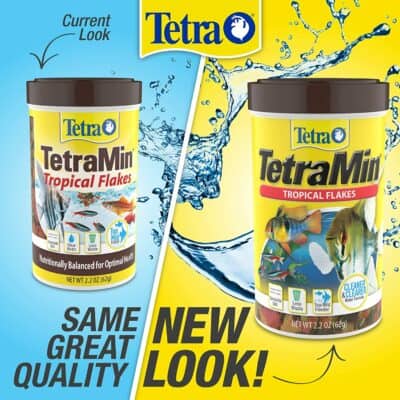
Editor’s Rating:
Why we like it: Tetra has been in the fish food game for years now, so it's no wonder that they've come to produce some top of the range Betta flakes, filled with vitamins and growth stimulants for a complete diet.
Quick Facts:
- Type: Semi-Floating Flakes
- Amount Required: Feed 2 to 3 times a day, only as much as can be consumed in 3 minutes
- Ingredients: Fish Meal, Celery, ProCare with Immunostimulants, Vitamins, Biotin, and Omega 3
When it comes to flakes, your Betta must recognize it for food and not just debris raining down on them, and you’ve got to make sure to catch their eye while easing your little aquatic chum into their new fish food source. Some flakes made of cheap, low-quality fish meal will fail to meet these goals, but this high-quality flake from TetraMin gets the job done. Flakes also provide just as much sustenance as any other food, and these TetraMin are no exception, delivering a mixture brimming with nutrients and growth stimulants.
Overfeeding can be an issue when it comes to flakes, not to mention how they sometimes clump together, leaving a soggy, unappetizing mess at the bottom of the tank. Carefully measure out how much you’re feeding by breaking it down finely beforehand or consider a pellet like the Hikari Bio-Gold Baby Pellets that will be easier to portion. Once these flakes are then in full feeding rotation, you should see the health of your Betta progress.
Contents and Nutrition
Covering everything required in the daily diet, these are some of the most balanced Betta flakes on the market to date. Keeping dangers such as stress at bay, TetraMin contains vitamins and stimulants that help build and improve the immune system. The flakes also include ProCare, ensuring the Betta grow to be strong and healthy, living longer and more active lives.
Pros
- Provides a robust, balanced diet
- Strengthens the immune system
- Helps promote growth
- Promotes long disease-free lives
Cons
- Sometimes mistaken for debris
- Need to break up the flakes first
2. Best Balanced Betta Food: Hikari Bio-Gold Baby Pellets
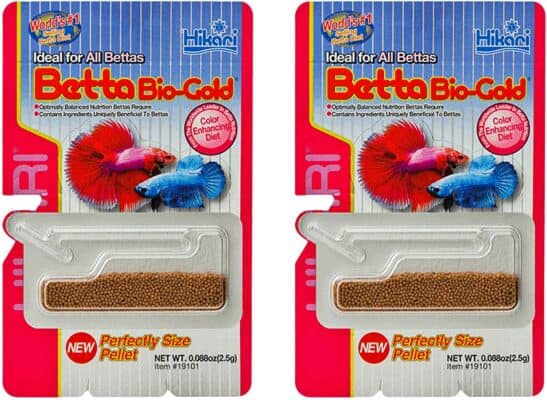
Editor’s Rating:
Why we like it: This option from Hikari provides a full, balanced diet through a complete everyday meal. Since you just pop it in, it's a quick and easy choice that's ideal for any busy Betta owners on the go.
Quick Facts:
- Type: Floating Pellets
- Amount Required: Between 5 and 10 Pellets up to 3 Times a Day
- Ingredients: Fish Meal, Grape Seed Extract, Astaxanthin, Spirulina
At the top of their game here, Hikari excels with these pellets, giving those fish the pick-me-up they deserve. Small and easy for most Bettas to manage, they won’t be posing any problems getting them down. Also, since these pellets float, they help keep the aquarium clear, meaning water changes won’t be as frequent.
You may find a little trouble dispensing them initially, mainly due to their size, but overall they’re pretty straightforward. All you need to do is drop the pellets in, and the job is complete, making these some of the better Betta fish food currently out there.
Contents and Nutrition
Hikari has gone all out here, packing the protein into these dehydrated fish meat dinners. Digestion shouldn’t be a problem either, being small with plenty of moisture also provided. One central ingredient is fish meal, which is unfortunate, and there are a few other filler contents thrown in there padding out the pellets. Balanced with the vitamins needed, though, these notably include the all-important Vitamin C. Color enhancers are also there, with plenty of Astaxanthin, keeping your little fishy friend positively radiant.
Pros
- Provides color enhancers
- Small and manageable
- Plenty of protein and Vitamin C
- Keeps the water clear
Cons
- A few filler ingredients
- Some trouble dispensing
3. Best Small Betta Food: Fluval Bug Bites Granules
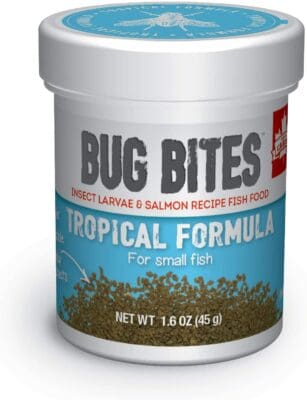
Editor’s Rating:
Why we like it: Bite-size and filled to the brim with nutrients, these easy to swallow pellets from Fluval contain less of the junk and more of the natural pep needed to get the little swimmers whizzing around the tank in no time.
Quick Facts:
- Type: Sinking Pellets
- Amount Required: 2 to 3 times daily, as much as is eaten in 2 minutes
- Ingredients: Black Soldier Fly Larvae, Salmon, Fish Protein, Green Peas, Potato
Digesting some of the larger pellets can be an issue for smaller fish, which is where these Bug Bites step in to save the day. Mostly made from natural food sources, they’re not only manageable but nourishing too. Taking the time out to process them in smaller batches, Fluval has paid close attention to detail, filtering a lot of the junk that often hamper such a product.
While smaller fish will have the time of their fishy lives with these, larger Betta may fail to spot them, missing out on a slap-up meal. The pellets vary in size but stick to the smaller side, so you’ll need to know your own individual Betta’s personal preferences beforehand. Either way, these are quick and easy nibbles, and Fluval has stepped up with some high-quality small and digestible fish food granules.
Contents and Nutrition
Holding a lot of nutrition in their Fly Larvae and Salmon ingredients, the Fluval Bug Bites contain high protein levels. Offering a balanced daily diet aimed at growth, they also contain all-natural minerals and vitamins. With Omega 3 and 6, they also improve the fish’s skin, along with the scales and fins, leaving little room for artificial colors and fillers.
Pros
- Natural ingredients
- High levels of protein
- Contains little filler
- Good for the skin and scales
Cons
- Granules can vary in size
- Larger fish may miss them
4. Best Budget Betta Food: Tetra Floating Mini Pellets
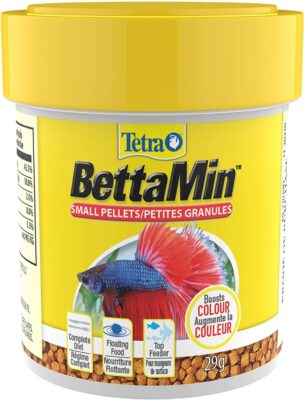
Editor’s Rating:
Why we like it: Inexpensive and nourishing, these mini-pellets from fish food favorites Tetra offer some budget bites for a fraction of the price while also not skimping on any nutrients.
Quick Facts:
- Type: Floating Pellets
- Amount Required: 2 to 3 times daily, and however much gets eaten in several minutes
- Ingredients: Wheat Flour and Gluten, Dried Fish and Potato Proteins, Soybean, Fish Meal
Bank balance friendly, Tetra Mini Pellets contain everything needed for a straightforward daily meal. There are higher quality pellets through Hikari, but the price is what sells these. Ideal as a ready-to-go cheaper alternative, they’re an excellent pellet supplement for keeping that fishy hunger at bay.
That said, some smaller fish are known to reject them and, while you can break them down if needs be, they might not be for everyone. There’s no water pollution, though, which is a definite plus point, as the tank is left crystal clear. Floating time is also high, and if they do take to them, your Betta will be sure not to miss them when lunchtime arrives.
Contents and Nutrition
As you’d expect with the budget option, the nutrients provided are pretty standard as pellets go, but they generally cover the Betta balanced diet. With a fair amount of filler packed in there, it’s nothing too unhealthy, providing plenty of color enhancement and boosting the immune system along the way. With ProCare in there as well, most fish should find themselves satisfied with this product at the very least.
Pros
- Inexpensive alternative
- Provides a balanced diet
- Immune system boosters
- Color enhancers
Cons
- Digesting can be challenging for smaller fish
- Some filler ingredients
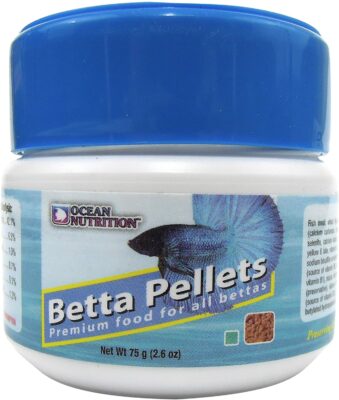
Editor’s Rating:
Why we like it: Not only do these pellets ensure the Betta remain in full glorious Technicolor, but their premium ingredients keep from polluting the tank.
Quick Facts:
- Type: Floating Pellets
- Amount Required: Feed up to 7 pellets twice daily
- Ingredients: Fish Meal, Cereal, Krill, Minerals, Vitamins, and Preservatives
Providing premium pellets that are both tasty and nutritious, these feed the little swimmers from the surface. Their easily digestible small size shouldn’t pose a problem, with not much breaking off, leaving the water clear and free of pollution.
One downside is that they don’t float for all that long, meaning your Betta needs to be quick if they want to catch their lunch. With fussier eaters kept in mind during production, this shouldn’t be a problem with their premium taste and ingredients. There’s still a little filler and Fish Meal in them, which is unfortunate given the price, but they offer the most premium contents over everything else that’s currently on offer.
Contents and Nutrition
They’re relatively close to the Aqueon Pro Betta Pellets in terms of nutrition and makeup. Ocean’s Nutrition does offer the more rounded meal, with its tasty mix leaving bellies full. It’s well worth your consideration for this alone. You undeniably get what you pay for, with its inviting combination of natural vitamins and color enhancers.
Pros
- Quality natural ingredients
- Tastes good
- Little filler used
- Doesn't cloud the tank
Cons
- Can sink fairly quickly
- Not so cheap
6. Best Bloodworms for Bettas: San Francisco Bay Bloodworms
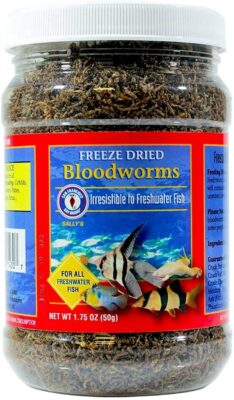
Editor’s Rating:
Why we like it: Your fish deserve a little treat now and again, and these Bloodworms provide just that, with no extra additives or filler, offering a freeze-dried snack that's both yummy and delicious.
Quick Facts:
- Type: Freeze-Dried Bloodworms
- Amount Required: Replaces meals once or twice a week
- Ingredients: Bloodworms Freeze-Dried
Going wild for Bloodworms is typical among Betta fish, marking it as a clear highlight of any feeding schedule. Similar to Brine Shrimp, if fed once a week, maybe twice if they’ve behaved, the Bloodworm is a delicious fishy freeze-dried snack. They may not be incredibly nourishing health-wise, but they keep your fish happy and beaming.
Mostly sinking to the bottom, your fish can easily enjoy picking them out; just make sure to keep them from hitting the filter. You won’t be using them all that often, though, so this shouldn’t be much of a problem. Fitting into your weekly schedule, they keep for extended periods, making them ideal for when treat time comes around.
Contents and Nutrition
Offering what’s on the packet, it’s freeze-dried Bloodworms all the way. Containing few parasites, they stay fresh, typically with a minimum of 51% crude protein in the mix. Just don’t let them replace regular meals as, with their low nutrition, they are most suited for weekly treats instead.
Pros
- No filler
- Lasts for long periods
- Great for treats
- Few parasites
Cons
- Can affect the filter
- Low nutritional value
7. Best Natural Betta Food: Aqueon Pro Betta Pellet
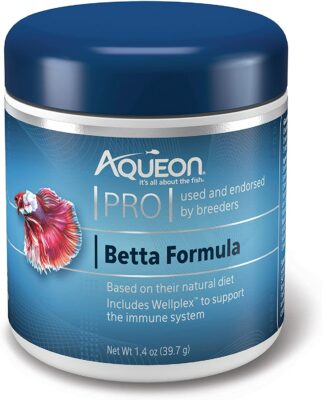
Editor’s Rating:
Why we like it: Sometimes it's better to head back to nature, and these pellets offer just that, with their all-natural ingredients that replicate the Betta diet of the wild, delivering a tasty and nutritious meal.
Quick Facts:
- Type: Floating Pellets
- Amount Required: However much can be eaten in 2-3 minutes, 2 to 3 times daily
- Ingredients: Wheat, Fish Meal, Shrimp, Fly Larvae, Krill, Pea Protein, Color Enhancers
Designed around the Betta’s natural diet, these pellets attempt to replicate nature as closely as possible. Boosting them daily, they float on the surface keeping their feeding and diet all-natural. Strengthening your Betta’s immunity and warding off disease, it keeps them fit and healthy.
As they break apart, the pellets can slightly cloud the water, which isn’t good for visibility. When it comes to balanced natural diets, though, you can’t beat them. These pellets help in giving your Betta the feeling of swimming wild. Using them regularly, they can help transition a fish into a new tank, keeping them comfortable and happy.
Contents and Nutrition
With nutritionists’ advice, these pellets have been specially designed by Aqueon, with plenty of fat and fiber in their meat. Containing 38% crude protein, with 30% being the recommended minimum, they offer everything for a balanced meal. One major downside is the inclusion of Fish Meal, which is unfortunate when it contains so many other nourishing ingredients. For pickier eaters, Ocean Nutrition Atison’ s is available. Either way, this has plenty of natural color enhancers, macro and microalgae, and vitamins to help make up for its shortcomings.
Pros
- Plenty of protein, fiber, and fat
- Natural ingredients
- Supports the immune system
- Formulated by nutritionists
Cons
- Contains Fish Meal still
- Sometimes clouds the water
8. Best Freeze-Dried Betta Food: Hikari Freeze-Dried Daphnia
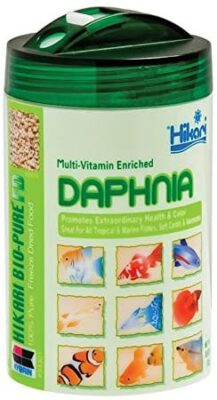
Editor’s Rating:
Why we like it: Bloating is a common occurrence in every Betta fish's lifespan, and these Daphnia are ideal for alleviating that, helping to clear out the system giving them the freeze-dried reboot they need.
Quick Facts:
- Type: Freeze-Dried Daphnia
- Amount Required: Feeding daily up to 3 times, it’s however much can be eaten in 3 to 5 minutes
- Ingredients: Daphnia, Vitamin Supplements
Overall
When your fishy friend shows signs of bloating, it may be time to get the freeze-dried Daphnia out. One of the cleanest freeze-dried products currently available, this is kept fresh right up until it’s popped in the tank. Along with their Bio-Gold Baby Pellets, Hikari is known for their high-quality, with this being ideal for sick tummies.
Using it to administer medicines, Daphnia is excellent for perking your Betta right back up again. Making the water’s surface a little cloudy, it does have a dust-like consistency, but it’s ideal for swooping in and nursing the little nippers back to health. Either way, it’s not a regular meal substitute, meaning water pollution won’t be too much trouble here.
Contents and Nutrition
Containing numerous vitamins along with Daphnia, this helps reduce stress, keeping the Betta at ease and free from disease. They also work as a mild laxative, helping clear out the system when facing any illness, and they’re easy to slip into the feeding schedule when necessary. While this may not be so frequently, they are a tasty high protein treat for lifting that smile and recharging when needed.
As well as the Daphnia, there are numerous vitamins, reducing stress and keeping the Betta relaxed and disease-free. Clearing out the system as well, it also works as a mild laxative. Another tasty treat, you can lift that smile and recharge your fish with this high-protein snack.
Pros
- Assists medication
- Useful as a mild laxative
- Helps with stress
- High protein for health
Cons
- Dust like consistency
- Not ideal for regular meals
9. Best Sinking Pellets for Bettas: New Life Spectrum
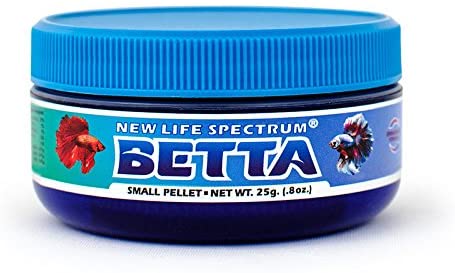
Editor’s Rating:
Why we like it: Parasites and illness can be a severe problem for your Betta if not treated, which is where these pellets come in, taking time to sink with their all-natural pick-me-up.
Quick Facts:
- Type: Sinking Pellets
- Amount Required: Twice daily, and as much as can be eaten in a minute
- Ingredients: Squid and Bentonite Clay, Krill, Spirulina, Garlic, Seaweed
Sharpening the color of your Betta through enhancements, brightness is the leading factor here. Floating, the granules sit waiting to be snapped up by the fish, with their all-natural ingredients. Easy on the tummy, they’re an excellent dish for any picky eaters out there.
This niche taste is also a downside, as it’s a case of ‘they either love it or hate it.’ Many fish reject them, so don’t get too invested in the idea, giving it a trial run, then switching if they swim in the opposite direction. The sizes can vary drastically too, which may also be off-putting to some. Once you know if your fish has a taste for them, it’s time to fit them into your regular feeding schedule.
Contents and Nutrition
Free of hormones and additives, these pellets work on enhancing the Betta’s color naturally. Also containing minerals, garlic is used for its anti-parasitic properties while boosting the immune system. Held together with Bentonite Clay, algae meal also helps provide vegetable and fruit extracts for a more balanced, rounded diet.
Pros
- Color enhancing
- Anti-parasitic properties
- Natural ingredients
- Take time to sink
Cons
- Specific taste
- Inconsistent sizing
10. Best Shrimp for Bettas: Omega One Brine Shrimp
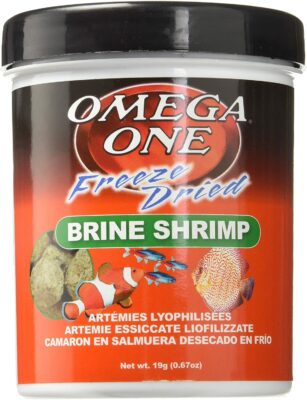
Editor’s Rating:
Why we like it: Treating your Betta to a little Shrimp will always go down a treat, and these freeze-dried Brine snacks are perfect for that, being free of all parasite bacteria.
Quick Facts:
- Type: Freeze-Dried Brine Shrimp
- Amount Required: 3 times daily, with as much as can be consumed in 2 minutes
- Ingredients: Brine Shrimp Freeze-Dried
Much like the Bloodworms, these freeze-dried brine shrimp also offer a tasty treat. Not relying on it too often, it works as a weekly snack containing plenty of protein and is excellent for acclimatizing your fishy pals.
You need to watch out when it comes to the tank itself, as it does arrive in large chunks, which can potentially damage smaller aquariums. Crumbling it up into as fine a powder as possible and just sprinkling is one option. You can also press the feed against the inside of the glass. Then, releasing the air, suction it in the water against the glass. You can then keep it out of the filter’s way while also generating some excitement in the tank itself. You may then have another occasional tasty in rotation, should they appreciate it.
Contents and Nutrition
By and large, this is free from most, if not all, fillers, so you’ll be getting what it says on the packaging. Omega 6 is perfect for building up the immune system, helping to prevent disease. Free from all bacteria, parasites in the feed aren’t an issue either, making this one of the safest options out there.
Pros
- Plenty of protein
- Free of parasites and bacteria
- Builds immunity
- Filler free
Cons
- Problem for filters and smaller tanks
- Not ideal for a regular diet
Guide to Buying the Best Betta Food in 2025
Not so difficult to care for as you may think initially, Bettas are, generally speaking, easy to look after. While we had a brief look at what caring for a Betta entailed, here we’ll break it down for you.
Feeding Your Betta Fish
There’s a lot more than just buying the perfect food to take into account when it comes to your Betta, so be sure to follow these guidelines.
Amount Required
Your fish will give you plenty of indicators of how much they’d like, and you’ll find that it varies between fish. The food package will offer general guidelines on feeding amounts, acting as a good starting point.
Feeding Schedule
Most Betta fish require two main meals a day, just like most humans. You especially want to make sure that a strict feeding schedule is kept to while they continue to grow. If you think you’ll struggle to keep things consistent, we recommend purchasing an automatic fish feeder that can be set to your Betta’s preferred schedule.
Malnourished Fish
The main fear of not feeding your fish is that it will become malnourished and eventually starve. Typically a fish can go for around fourteen days without a meal, but you want to avoid putting this to the test if at all possible. A healthy fish is a happy fish!
Overfeeding Dangers
As well as driving many corny sitcom cliches, this is a crucial concern when feeding your Betta. You don’t want to overfeed your fish, or anyone else’s, only to see it bloating up and floating to the surface.
Maintaining Your Aquarium When Feeding
Your aquarium will also be affected by the food you use, so it’s useful to lessen the impact of your fish feeding on your aquarium by keeping in mind a few factors.
- Water Pollution: from flakes to pellets, some foods will break up, creating a cloudy effect, and this can pollute the water, giving it a mist and ultimately making the tank dirty.
- Filter: like water pollution, you don’t want to see your filter getting clogged up, and some fish foods can do this as they tend to drift over towards it. Some floating aquarium plants can act as a filter, but you’ll still need a mechanical filter even if you turn your tank into an underwater garden.
- Foliage and Decoration: this is more for the benefit of the Betta fish themselves, as food can be lost and hard to find among algae and ornaments, leaving it to go to waste.
Betta Fish Feeding FAQ
How Much Do Bettas Eat?
Firstly, it’s important to remember that fish do not and have never regulated their appetite, regardless of what you may have heard prior. Always on the hunt for prey in the wild, they often find themselves with empty stomachs. You need to keep an eye on this, as they won’t do it for you.
At the risk of sounding extremely obvious, your Betta’s size will be your first indicator. One way of determining the pellet’s size is by measuring them against the fish’s eyeball, as not only can they see and recognize it, but they can also digest it. 5% of the fish’s body weight is another useful measurement, proportioning your helpings to this size when dishing it out. Once you have an amount you think might be most suitable, go ahead and sprinkle it in, seeing how much the fish consumes in two minutes. If they’re an incredibly slow muncher, increase the time to five minutes and see how they fare.
The package’s directions should suffice for the most part, but you should find your feeding system as you get to know your fish better. Just remember that whatever hits the bottom of the tank, you will usually find yourself having to clear out later.
When Should I Feed My Betta?
Ideally, anywhere between two and six smaller portions spread out over a day is best. You’ll need to space them out with a few hours in-between, and this will ensure maximum growth potential. When it comes to minimum amounts for Betta, though, twice daily will usually suffice.
How Long Can Betta Fish Go Without Eating?
Younger fish will undoubtedly require their daily two meals, while you can be a little more relaxed with adults. As previously mentioned, fish may be able to last a fortnight without food, but don’t put this to the test. Vacations need accounting for, so be sure to call in a friend to take care of them before leaving. On the other hand, if you are going out for the evening, simply skip a meal instead of cramming it all into one.
What Dangers Are There to Overfeeding Bettas?
Two of the main conditions of overfeeding are bloating, leading to more severe conditions like ‘Dropsy,’ along with constipation. To help prevent this, some owners may fast their fish once a week or fortnight, although there are no conclusive studies to prove this is useful. As the name suggests, visible bloating is a clear sign the fish is unwell. Not creating much waste is another definite indicator. While constipation is common, bloating requires that you hold back from feeding until their abdomens return to normal. Blanched peas are known to alleviate constipation, and you can prepare this yourself, feeding only a small portion to the sick fish.
Feeding and Aquarium Maintenance
An important point to remember is that the Betta is primarily a surface feeder, which must be kept in mind when purchasing food and buying a tank. Lurking under the surface, they’re prone to speedily nipping insects and whatever else may settle there. Products such as pellets are essential here, as ones that sink quickly are especially prone to losing in the vastness of the tank, leaving your unfortunate fish to starve. Not only that, but the food itself will break down, leaving the tank dirty and, eventually, uninhabitable.
Putting extra strain on the filter, this also means choosing a food that floats for longer while finding an aquarium with a larger surface area. You want a tank equipped for feeding -and surface area, along with foliage and decorations, is just as critical to take into account.
Fish Food for Thought
A healthy fish is a happy fish, which means being well-fed with a belly full of grub. Remembering key factors such as protein is vital, getting the balance between nourishing and what their little taste buds enjoy. Shopping around and trying out different brands is where you want to start and, by the end of it, you should be able to settle on a feeding schedule that will bring you both peace of mind.
